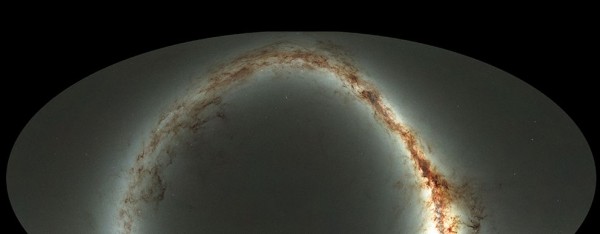Astronomers Release World’s Largest Digital Survey of the Visible Universe
| Arthur Dominic Villasanta | | Dec 19, 2016 10:21 PM EST |
(Photo : Danny Farrow, Pan-STARRS1 Science Consortium and Max Planck Institute for Extraterrestial Physics) This compressed view of the entire sky visible from Hawaii by the Pan-STARRS1 Observatory was taken over a period of four years. The disk of the Milky Way looks like a yellow arc, and the dust lanes show up as reddish brown filaments. The background is made up of billions of faint stars and galaxies.
The Pan-STARRS project at the University of Hawaii Institute for Astronomy has just publicly released the world's largest digital sky survey that mapped billions of stars and galaxies in the visible Universe via the Space Telescope Science Institute (STScI) in Baltimore, Maryland.
Like Us on Facebook
Astronomers and cosmologists used a 1.8 meter telescope at the summit of Haleakalā, on Maui, Hawaii, to repeatedly image three quarters of the visible sky over four years.
The data captured in the Pan-STARRS1 Surveys consists of three billion separate sources, including stars, galaxies and other space objects. This massive collection of information contains two petabytes of computer data, or the equivalent of one billion selfies or one hundred times the total content of Wikipedia.
Pan-STARRS is hosted by the University of Hawaii Institute for Astronomy, which is releasing the data alongside the Space Telescope Science Institute in Baltimore, USA.
The data can be accessed at http://panstarrs.stsci.edu.
The international collaboration also includes Queen's University Belfast and the Universities of Durham and Edinburgh and is supported by NASA and the National Science Foundation. Durham's contribution was funded by a donation from the Ogden Trust and Durham University.
"The Pan-STARRS1 Surveys allow anyone to access millions of images and use the database and catalogs containing precision measurements of billions of stars and galaxies," said Dr. Ken Chambers, Director of the Pan-STARRS Observatories.
"Pan-STARRS has made discoveries from Near Earth Objects and Kuiper Belt Objects in the Solar System to lonely planets between the stars; it has mapped the dust in three dimensions in our galaxy and found new streams of stars; and it has found new kinds of exploding stars and distant quasars in the early universe.
"With this release we anticipate that scientists - as well as students and even casual users - around the world will make many new discoveries about the universe from the wealth of data collected by Pan-STARRS."
The first Panoramic Survey Telescope & Rapid Response System (Pan-STARRS) observatory is a 1.8 meter telescope at the summit of Haleakalā, on Maui.
In May 2010, it embarked on a digital sky survey of the sky in visible and near infrared light. This was the first survey to observe the entire sky visible from Hawaii multiple times in many colors of light, with the goal of finding moving, transient, and variable objects, including asteroids that could potentially threaten the Earth.
The survey took four years to complete, and scanned the sky 12 times in each of five filters.
"Achieving the high quality of the Pan-STARRS1 measurements and maintaining it over such an enormous quantity of data was a unique computational challenge and the results are a tribute to the dedicated efforts of our small team of scientists at the UH IfA and our collaborators who worked to process and calibrate the extraordinary volume of raw image data," said Dr. Eugene Magnier, lead of the Pan-STARRS Image Processing team.
This research program was undertaken by the PS1 Science Consortium -- a collaboration among 10 research institutions in four countries with support from NASA and the National Science Foundation (NSF).
Consortium observations for the sky survey, mapping everything visible from Hawaii, were completed in April 2014.
The roll-out is taking place in two stages. The first release is the "Static Sky," which is the average of each of individual epoch.
For every object, there's an average value for its position, its brightness, and its colors. In 2017, the second set of data will be released, providing a catalog that gives the information and images for each individual epoch.
The Space Telescope Science Institute provides the storage hardware, the computers that handle the database queries, and the user-friendly interfaces to access the data.
The survey data resides at the Mikulski Archive for Space Telescopes (MAST), which serves as NASA's repository for all of its optical and ultraviolet-light observations t.
It includes all of the observational data from such space astrophysics missions as Hubble, Kepler, GALEX, and a wide variety of other telescopes, as well as several all-sky surveys. Pan-STARRS marks the nineteenth mission to be archived in MAST.
TagsUniverse, world's largest digital sky survey, Pan-STARRS1 Surveys, Space Telescope Science Institute, University of Hawaii Institute for Astronomy
©2015 Chinatopix All rights reserved. Do not reproduce without permission
 Verlinde’s ‘Emergent Gravity’ Theory Dismisses Gravity as a Fundamental Force
Verlinde’s ‘Emergent Gravity’ Theory Dismisses Gravity as a Fundamental Force Astronomers Meet to Finalize the ‘Square Kilometer Array,’ the World’s Largest Radio Telescope
Astronomers Meet to Finalize the ‘Square Kilometer Array,’ the World’s Largest Radio Telescope China’s New KDUST Telescope in Antarctica to begin Operations in 2020
China’s New KDUST Telescope in Antarctica to begin Operations in 2020 Dark Matter Might Soon be Discovered Thanks to New Calculations
Dark Matter Might Soon be Discovered Thanks to New Calculations
EDITOR'S PICKS
-

Did the Trump administration just announce plans for a trade war with ‘hostile’ China and Russia?
-

US Senate passes Taiwan travel bill slammed by China
-

As Yan Sihong’s family grieves, here are other Chinese students who went missing abroad. Some have never been found
-

Beijing blasts Western critics who ‘smear China’ with the term sharp power
-

China Envoy Seeks to Defuse Tensions With U.S. as a Trade War Brews
-

Singapore's Deputy PM Provides Bitcoin Vote of Confidence Amid China's Blanket Bans
-

China warns investors over risks in overseas virtual currency trading
-

Chinese government most trustworthy: survey
-

Kashima Antlers On Course For Back-To-Back Titles
MOST POPULAR
LATEST NEWS
Zhou Yongkang: China's Former Security Chief Sentenced to Life in Prison

China's former Chief of the Ministry of Public Security, Zhou Yongkang, has been given a life sentence after he was found guilty of abusing his office, bribery and deliberately ... Full Article
TRENDING STORY

China Pork Prices Expected to Stabilize As The Supplies Recover

Elephone P9000 Smartphone is now on Sale on Amazon India

There's a Big Chance Cliffhangers Won't Still Be Resolved When Grey's Anatomy Season 13 Returns

Supreme Court Ruled on Samsung vs Apple Dispute for Patent Infringement

Microsoft Surface Pro 5 Rumors and Release Date: What is the Latest?










